The magic of eclipses
A total solar eclipse is simply the most awe-inspiring, breathtaking show that nature has to offer. The Sun disappears in the daytime sky as the Sun and Moon align, suddenly turning the sky to a deep twilight. It is an amazing sight as the Sun appears as a black hole in the sky surrounded by the Sun’s beautiful white atmosphere (the corona) streaming out from the Sun in the shape of the Sun’s magnetic field. The Sun’s bright red upper surface (the chromosphere) makes an appearance. Planets and stars magically appear in the deep blue sky providing a unique view of our Solar System that can only be seen during a total solar eclipse.
It is not only the eclipse itself. In the hour leading up to the total eclipse the temperature gradually drops. In the few minutes before the total eclipse the Moon’s shadow, appearing just like a dark threatening thunderstorm, approaches swiftly and silently from the west. As the total eclipse arrives there are sunset colours all around the horizon. And then, at the end of the total eclipse the Sun takes on the appearance of a dazzling diamond ring in the sky, a never to be forgotten sight!



What are eclipses?
It is easy to understand why the combination of the Sun disappearing in an otherwise normal day, the ominous, almost threatening arrival of the Moon’s shadow, the chill in the air and the eerie light filling the sky so terrorized ancient people. Even now as we completely understand the phenomena as a wonderful demonstration of the universe in motion, it remains an awe-inspiring event that many people describe as a deeply emotional experience.
A total solar eclipse is a must see bucket list item. The good news is that there are five opportunities between now and 2038 to see one in Australia. The first two of these are on 20 April 2023 and 22 July 2028. Don’t miss the chance of a lifetime to witness the beauty of the cosmos on display.
How does a solar eclipse occur?
The Sun and Moon appear in the sky to be roughly the same size, but their sizes are actually very different. By a fortuitous coincidence, the Sun is about 400 times larger than the Moon, but the Sun is also about 400 times further away. So, the Moon is able to just cover the Sun completely during a total solar eclipse.
A solar eclipse (eclipse of the Sun) occurs when the Moon, in its orbit around Earth, passes between Earth and the Sun, making an alignment between the Sun, Moon and Earth. As seen from Earth, the Moon completely covers the Sun’s bright disc, and this casts a shadow on Earth. There are two parts to the Moon’s shadow. The dark inner cone shaped part is called the umbra and the lighter outer part is called the penumbra. From a location within the umbra the Sun is completely hidden and for an observer on Earth in the umbra there will be a total solar eclipse as the Moon will completely obscure (eclipse) the Sun. From a location within the penumbra the Moon will only partially obscure the Sun so that from these locations there will be a partial solar eclipse. See Figure 1.
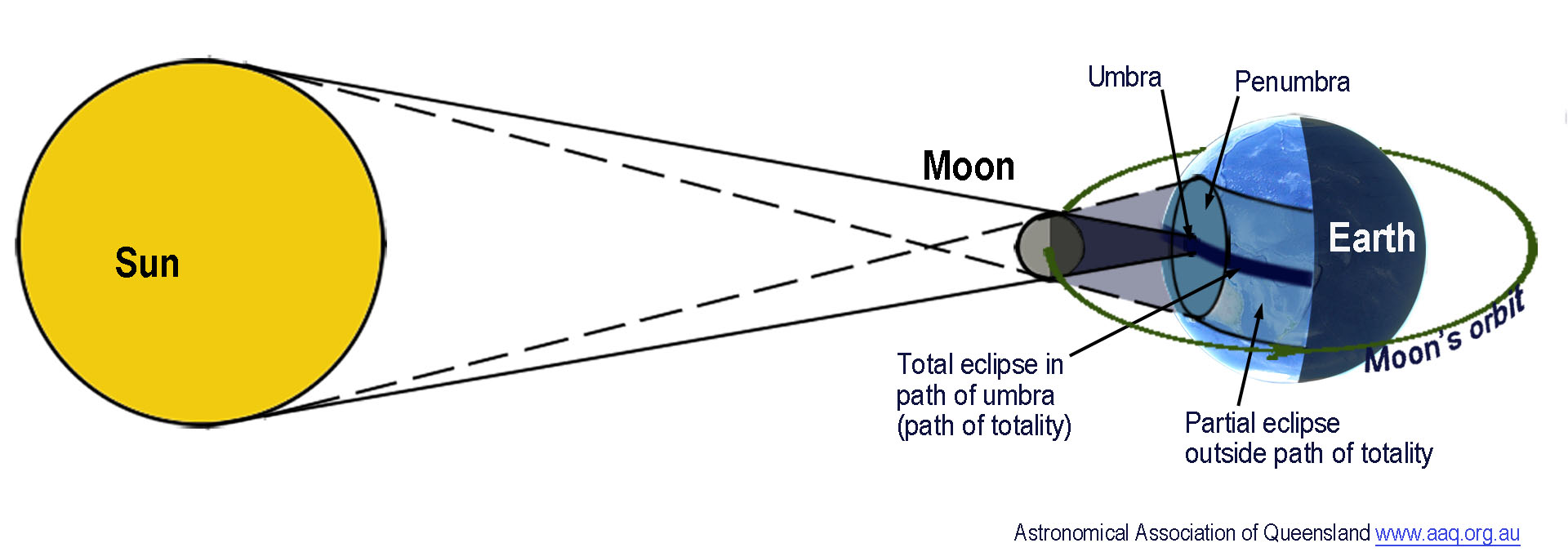
The period during which an eclipse is total at any location is called totality. As the Moon orbits Earth and Earth rotates, the Moon’s shadow moves across Earth’s surface from west to east with the umbra tracing out a narrow path called the path of totality. For any location in the path of totality, the Moon, over a period of an hour or so, will firstly appear to cover the Sun progressively in the partial phase of the eclipse. As the umbra arrives at that location, the Sun will be completely covered and there will be a total solar eclipse. As the umbra moves on, the Moon from that location will appear to gradually uncover the Sun in the final partial phase of the eclipse, which generally takes about another hour.
At any point on Earth’s surface outside the path of totality but crossed by the penumbra, the Moon will only partly cover the Sun, reaching a point of maximum coverage and then move on to uncover the Sun. So this location will experience only a partial solar eclipse. Any point on Earth’s surface not crossed by the penumbra will not see any eclipse. Sometimes the umbra does not cross Earth (passing above or below Earth in space) and there may be a partial eclipse without there being a total eclipse anywhere.
The shadow of the umbra will travel across Earth in a path thousands of kilometres long, usually taking about three hours or so and travelling at speeds between 2 000 to more than 12 000 kilometres per hour along different parts of the path.
The close match between the apparent size of the Sun and the Moon in the sky is a key reason for some of the spectacular effects of a total solar eclipse and is the reason why the width of the path of totality is quite narrow, typically no more than about 270 km. The maximum duration of the total part of any eclipse depends mainly on the actual distances of the Sun and Moon from Earth at the time and can last from only a few seconds to over seven minutes. Tidal friction is slowly pushing the Moon away from the Earth at about 3 centimetres per year. In the far distant future, the Moon will not completely cover the Sun and only annular solar eclipses (where the Moon does not completely cover the Sun) will occur. See Annular Solar Eclipse for a detailed description of this type of eclipse.
A NASA visualization of how the Moon creates a total solar eclipse with reference to the 2017 eclipse is at: https://www.nasa.gov/feature/goddard/2017/the-moon-is-front-and-center-during-a-total-solar-eclipse.
What happens during a solar eclipse?
The sequence of events that occur during a solar eclipse depends on whether the observer is inside the path of totality and can experience all the amazing effects of the total eclipse or is outside the path of totality and can experience the limited effects of a partial eclipse.
Partial solar eclipse
A total solar eclipse starts with a partial eclipse as the Moon gradually covers the Sun. After totality ends there is also a partial eclipse as the Sun is gradually uncovered.
Outside the path of totality and within the area swept by the Moon’s penumbra, a partial solar eclipse will also occur where the Moon will gradually cover the Sun, creating a crescent shape, and progress to increasing coverage. The proportion of the Sun’s diameter that is covered (called the magnitude of the eclipse) will increase to a maximum and then reduce again as the Moon moves across the Sun. See Figure 2 which shows the progression of a partial solar eclipse of maximum magnitude 73%.

The whole partial eclipse can take up to about three hours. The maximum magnitude of a partial eclipse and the duration of the partial eclipse depend mainly on the distance of the observing location from the path of totality. As examples, for the maximum magnitude of the partial eclipse seen at various locations across Australia see Figure 2 of the eclipse of 20 April 2023 and Figure 2 of the eclipse of 22 July 2028).
During the partial phases, images of the crescent shape of the Sun can be seen projected under trees on the ground or onto adjacent walls, as the gaps between leaves act as pinhole projectors. See figure 3. The crescent shape of the Sun can be revealed using pinhole projection, mirror projection or binocular or telescope projection or using common items with holes in them such as a kitchen colander or a loosely woven straw hat. See Eye Safety for how to do this safely including the very important safety precautions.

Shadows become unnatural as the crescent Sun becomes thin, being sharp in one direction and blurry at right angles. This can be seen by observing the shadow of both hands with the fingers on one hand orientated at right angles to the fingers on the other hand as demonstrated in figure 4.
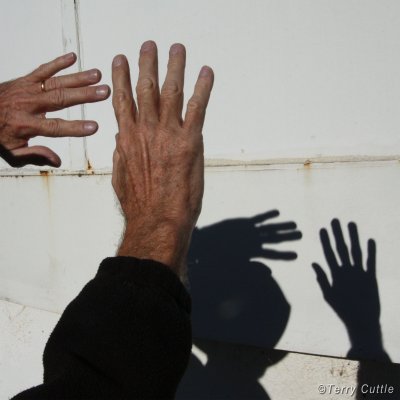
During a partial solar eclipse, the light level will decrease to an extent dependent on the maximum proportion of the Sun’s diameter covered (the magnitude of the eclipse). Because our eyes are very good at compensating for varying light levels, this will often go unnoticed until the Sun is reduced to a thin crescent.
As well as describing the coverage of the Sun at any particular point in the eclipse, individual eclipses are usually defined by their maximum magnitude simply called the eclipse magnitude. For a partial eclipse, the eclipse magnitude will be less than 100%, but for a total eclipse, the eclipse magnitude will be greater than 100% because in this case it is the ratio of the Moon’s diameter to that of the Sun. For example, for the relatively short eclipse of 20 April 2023, the eclipse magnitude will be 101.3%, while for the longer eclipse of 22 July 2028, the eclipse magnitude will be 105.6%. Eclipse magnitude can be as high as 108% when the Moon is closest to Earth and Earth is far from the Sun making the apparent size of the Moon significantly greater than the apparent size of the Sun.
How much of the Sun is eclipsed during a solar eclipse can alternatively be described by the term obscuration which is the fraction of the Sun’s area covered by the Moon. Magnitude is useful in describing the relative sizes of the Sun and Moon and how the coverage of the sun will appear to be as an eclipse progresses, whereas obscuration is useful in assessing the change in light level as it is a function of the area of the Sun covered. Obscuration can never be more than 100%. Both magnitude and obscuration can be expressed as a fraction (e.g. 0.7) or as a percentage (e.g. 70%).
Partial solar eclipses will be visible across the whole of Australia at the time of each of the five Australian total solar eclipses between now and 2038. See Five Australian Eclipses for details.
It is dangerous to directly view any part of a partial solar eclipse without proper eye protection. See the advice in Eye Safety for more information.
Total solar eclipse
A total solar eclipse starts with initial partial phases as described above, with the Moon progressively covering the Sun. After about an hour or so, the Moon completely obscures the Sun for a brief period in the total phase of the eclipse. The Moon then moves progressively off the Sun in the final partial phase, taking a further hour or so. See figure 5 which shows the full sequence of the total solar eclipse of July 2010 through the initial partial phase, totality and the final partial phase as the Moon moved across the face of the Sun.

The initial partial phase progresses with very little change being noticeable in the light level. As the total part of the eclipse approaches, the light level decreases conspicuously and an ominous darkening of the sky (the Moon’s shadow) approaches silently from the west. The Sun is reduced to a very thin crescent. The temperature can decrease (anything from a few degrees to over ten degrees) and the light quickly begins to fade. By this time animals have become confused at the fading light and often react as if it is nightfall with, for example, birds returning to roost.
For a minute or two before totality begins and for a similar time after it ends, narrow bands of shadow sometimes seem to race across the landscape. These shadow bands occur when regions of Earth’s upper atmosphere bend the final sliver of light from the thin crescent Sun.
In the final few seconds before totality the last brilliant parts of the Sun’s surface shine through valleys around the edge of the Moon in a shimmering display called Baily’s Beads. Finally, the beads are reduced to a single point, and the Sun for a few seconds looks like a dazzling diamond ring. The diamond ring and Baily’s Beads are clearly defined because of the lack of an atmosphere on the Moon.
Figure 6 is an image of the Diamond Ring at the total solar eclipse of 2005 in the South Pacific Ocean. The last portion of the Sun is shining through a valley on the edge of the Moon to create one dazzling point, and the Sun’s outer atmosphere (the corona) becoming visible around the rest of the Sun completes the effect.

As the last bright point winks out, the Sun’s red upper surface, the chromosphere, can be seen in an arc around the edge of the Moon. Often evident are prominences, bright red loops of plasma which extend above the chromosphere.
Figure 7 is a combination of four images showing Baily’s Beads with the transition at the start of the total part of the eclipse (known as second contact) at the total solar eclipse of 2006 in Egypt. Baily’s Beads are visible along with the bright red arc of the chromosphere. Several prominences are seen rising up from the chromosphere. As the Moon gradually moves during the sequence, Baily’s beads, the chromosphere and the prominences are progressively being covered.
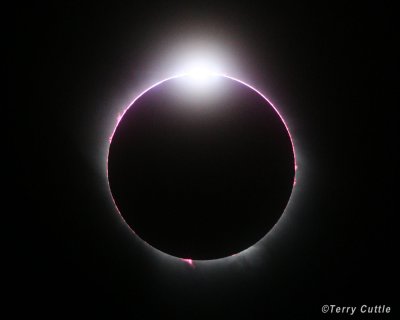
As the Sun disappears, the Moon’s shadow arrives, enveloping observers and causing the whole sky to become a dark steel blue, in a surreal twilight dramatically fainter than the daytime sky. During totality, when the Sun’s bright surface (photosphere) is completely obscured, the Moon appears as a black hole in the sky outlined by the Sun’s softly glowing pearly white corona, the Sun’s outer atmosphere composed of ionised gas. The corona curves out from the Sun, usually in a pattern formed by the Sun’s magnetic field. Observers can look for streamers in the corona and brush like lines at the north and south poles (called polar brushes or tufts) noting the length and distribution of the streamers and features, showing the Sun’s the magnetic field and the level of the Sun’s activity.
Figure 8 shows the corona during the eclipse in July 2010 in French Polynesia. Polar brushes are seen at the top and bottom coming from the Sun’s north and south poles. Several long streamers can be seen in the areas between the poles, and the Sun’s magnetic field is apparent. There is a prominence rising above the Moon on the left-hand side of the Sun.
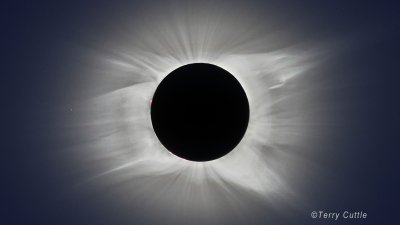
In the darkened sky, planets and bright stars become visible. One of the most amazing sights is seeing the Sun in the sky along with the planets. The planets are strung out in a line to just one side or both sides of the Sun. This is your exclusive side on view of the solar system, only visible during a total solar eclipse. Is easy to visualize how the planets orbit the Sun all in almost the same flat plane.
There is a glowing light around the horizon which has a sunset colour, caused by the scattering of different wavelengths of light in the atmosphere. See the explanation in the section on light and colours in the atmosphere.
Figure 9 shows the eclipsed Sun in the sky over the Great Wall of China in 2008. The dark area of the Moon’s shadow in the sky can be clearly seen as well as the pinkish sunset glow of the light from outside the shadow over the distant mountains. An expanded view of the image will reveal planets extending to the upper left of the Sun.

It is the dramatic change from daylight to almost night, the ominous darkening of the sky approaching silently from the west, the chill in the air and the sudden disappearance of the Sun in an otherwise normal day that so terrorised ancient people. Even today, when we understand what is happening, it is still a spine tingling and awe-inspiring event.
At the end of totality, the entire sequence is reversed, with prominences, chromosphere, diamond ring, Baily’s Beads and shadow bands again being visible. The Moon’s shadow races away to the east. The Moon then gradually uncovers the Sun, taking another hour or so until the final partial phase is over.
Some people see a partial solar eclipse and wonder why others talk so much about a total solar eclipse. There is a dramatic difference between the two.
Because the change in level of brightness from full Sun to being in a total eclipse is so great, even if you are close to the path of totality and the Sun is covered 99%, the light is still up to 1 000 times brighter than in the path of totality. It is too bright to see the corona, the chromosphere and any prominences and you will not be enveloped by the dark shadow or see Baily’s Beads or the diamond ring. Being just outside the path of totality is like almost winning the lottery - there is no prize for a ticket number that is close to the winning one.
Shown here are images illustrating some of the phenomena that can be observed during a total solar eclipse. Beautiful as the photographs are, no image, TV or video screen can make it become dramatically darker at midday, arousing some primal emotion. Nor can it effectively capture the beautiful, detailed structure in the Sun’s corona, something that only our eyes can see. You have to see and experience a total solar eclipse outdoors under an open sky to fully appreciate it.
Remember, never look directly at the bright surface of the Sun without suitable eye protection as permanent eye damage may result. This applies at any time and especially during the partial phases of a solar eclipse. See Eye Safety for safe methods of observing a solar eclipse.
Eclipse timing and eclipse contacts
Eclipse timing is usually given in terms of eclipse contacts. Figure 10 shows the four eclipse contacts for a total solar eclipse. The Moon progressively covers the Sun until the brief total eclipse and then it gradually uncovers the Sun. As the Sun moves across the sky, the Moon appears to move at a slower rate causing it to move across in front of the Sun.

Contacts are the points at which the apparent edges of the Sun and Moon cross one another:
- First Contact (C1): the Moon first begins to cover the Sun and is the start of the partial phase.
- Second Contact (C2): the Sun is first completely covered and is the start of the total part of the eclipse.
- Third Contact (C3): the Sun is at the point of being uncovered and is the end of the total part of the eclipse.
- Fourth Contact (C4) is when the Moon lastly touches the Sun and is the end of the final partial phase.
From a location where there is only a partial solar eclipse, there is only first contact and fourth contact.
Frequency of eclipses
Solar eclipses are not especially rare. Partial eclipses, in which the umbra of the Moon’s shadow never touches Earth, occur about three times every year. On average, there is a total solar eclipse somewhere on Earth about every 18 months. Annular solar eclipses occur a little more frequently than total solar eclipses. There is more information on this in Other types of solar eclipses.
What makes the appearance of a total solar eclipse so rare is because each path of totality only traverses a small area of Earth. The average time between successive total solar eclipses for any location on Earth, is about 350 to 400 years, although this can vary widely for individual locations. Some locations are fortunate to have repeat total solar eclipses in a much shorter time. As examples, see Figure 2 of Australia’s Five Total Solar Eclipses to see locations where any two of the paths of totality cross.
The plane of Earth’s orbit around the Sun is called the ecliptic. The Moon’s orbit around Earth is tilted at about 5 degrees with respect to the ecliptic. So, at each new moon, the Moon usually tracks “above” or “below” the Sun and is not able to block the Sun. It is only when the new moon is near to one of the two locations where the Moon’s orbit crosses the plane of Earth’s orbit that an eclipse is possible. These crossing points are called nodes. Figure 11 shows how the shadows line up and a total solar eclipse or a total lunar eclipse can occur when Earth is close to one of the two nodes, and the positions in space of the Moon’s and Earth’s shadows when Earth is not near the nodes. A total eclipse does not occur at every crossing of a node as the new or full moon may not occur close to the time when Earth is crossing the Node.
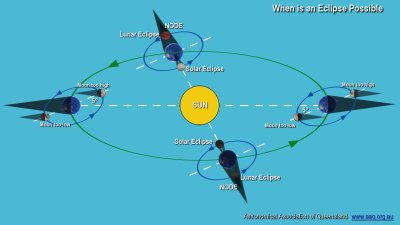
There is an eclipse season about every 6 months when the Sun is close to one of the nodes and an eclipse is possible. In 2023 this occurs in April and October. But the time between each successive crossing of the node and back again is less than a year (this period is called an eclipse year and is 346.6 days). So, over time the nodes move, and the eclipse season comes earlier. This is called regression of the nodes.
Solar eclipses repeat in a regular pattern called a saros which is a period of 18 years 11⅓ days. This is because
- 223 cycles from one full moon to the next (a lunar month), and
- 19 times between each successive crossing of the node and back again (eclipse years)
- both equal this period. In addition,
- 239 cycles of the Moon moving in its elliptical orbit from farthest point (called apogee) to closest point (called perigee) and back again (called the anomalistic month) also is very close to this period.
So, a very similar eclipse will occur 18 years and 11 days after a previous one. Because of the ⅓ of a day, it occurs ⅓ of the way round the world. All eclipses belong to a saros series, and each has been given a number. The eclipse of 20 April 2023 is part of saros number 129 while the eclipse of 22 July 2028 is part of saros number 146.
Other types of solar eclipses
A total solar eclipse does not always occur when the Moon moves directly in front of the Sun. Because the Moon in the sky can appear to be smaller than the Sun other types of eclipses can occur.
Annular Solar Eclipse
An annular solar eclipse occurs when the Moon passes directly in front of the Sun, but because the Moon at that time appears to be smaller than the Sun, it cannot completely cover the Sun and a ring or annulus of the Sun remains.
As the Moon is in an elliptical orbit around Earth, its distance from Earth varies and as a consequence its apparent size in the sky varies. Likewise, the apparent size of the Sun varies because Earth moves in an elliptical orbit around the Sun. These two factors combine to give the relative sizes of the Sun and the Moon. Sometimes the Moon appears larger than the Sun and at that time if the Moon passes in front of the Sun, it is easily able to completely cover the Sun and a total solar eclipse can occur.
At other times the Moon will appear smaller than the Sun and at these times, if the Moon passes in front of the Sun, it cannot completely cover the Sun and a ring or annulus of the bright surface of the Sun (the photosphere) remains. This is called an annular (Latin meaning ring) solar eclipse.
The sky does not go very dark and none of the spectacular events of a total solar eclipse can be seen. The umbra of the Moon’s shadow does not reach Earth as shown in figure 12.
The part of the Moon’s shadow that extends beyond the end of the umbra is called the antumbra. As the Moon orbits Earth and Earth rotates, the Moon’s shadow moves across Earth’s surface from west to east with the antumbra tracing out a narrow path called the path of annularity. Observers within the antumbra will experience an annular solar eclipse. The period during which an annular eclipse is occurring at any location is called annularity.

Similar to a total solar eclipse, the umbra and antumbra are surrounded by the Moon’s penumbra. From a location within the area traced out by the penumbra the Moon will only partially obscure the Sun so that from these locations there will be a partial solar eclipse.
The sequence of the Annular Solar Eclipse of 2010 is shown in figure 13. The eclipse starts as a partial eclipse progressing until the Moon moves in front of the Sun leaving a ring of sunlight. The Moon moves on during the final partial phases of the eclipse.

An annular eclipse is similar to a partial eclipse such that some of the bright surface of the Sun is always visible. Although the dramatic effects of a total eclipse do not occur, the same interesting shadow effects and projected crescent images seen at a partial eclipse can be experienced with the highlight being circular images seen at annularity (when the ring of sunlight surrounds the Moon).
Never look directly at the bright surface of the Sun no matter how little of the Sun’s surface is showing without suitable eye protection as permanent eye damage may result. This applies at any time and especially during the partial or annular phases of a solar eclipse. See Eye Safety for safe methods of observing a solar eclipse.
Total or annular?
As described above, the apparent sizes of the Sun and Moon in the sky vary due to the elliptical shape of Earth’s and the Moon’s orbits. The apparent size of the Sun can vary by about 3%. The apparent size of the Moon can vary by up to 14%. Figure 14 shows the variation in apparent size of the Moon as it moved from closest to Earth (known as perigee) to farthest from Earth (known as apogee) and the apparent size of the Sun as Earth moved from farthest from the Sun (known as aphelion) to closest to the Sun (known as perihelion) 2021.
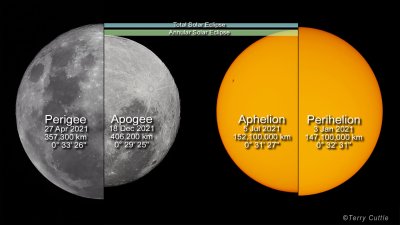
The size range of the Moon where a total solar eclipse would definitely occur because the Moon will always appear larger than the Sun is shown in aqua and the size range of the Moon where an annular solar eclipse would definitely occur because the Moon will always appear smaller than the Sun is shown in green with either type of eclipse possible in the intervening area. As the green band is wider than the aqua band, this shows that annular solar eclipses are likely to occur a little more frequently than total solar eclipses. On average, in every 100 years, there are about 79 annular eclipses and about 64 total solar eclipses
Hybrid Eclipse
The sections above describe partial, total and annular eclipses. Sometimes when there is a close match between the apparent sizes of the Sun and the Moon, the Moon’s umbra will be just long enough to touch Earth in the central part of the path but because of the curvature of Earth it will not be long enough to reach Earth at one or both ends of the path. In this case the eclipse path will normally start as annular, change to total then change back to annular or it may have annularity only at one end. In these cases, it is called a hybrid eclipse. It can also be called an annular – total eclipse. See figure 15 for how a hybrid eclipse occurs.

So, the term hybrid eclipse describes an eclipse that can be either total or annular depending on where along the path the eclipse is observed from. The eclipse of 20 April 2023 is a hybrid eclipse, but it will be a total eclipse as observed from the Western Australia region. Hybrid eclipses always have a relatively short duration of totality.
Hybrid eclipses are rarer than total or annular solar eclipses. On average there are about 10 hybrid eclipses in every 100 years.
Central Eclipse
A central eclipse is any type of solar eclipse in which the central axis of the Moon’s shadow traverses Earth (and does not pass above or below Earth in space). Central solar eclipses can be total, annular or hybrid.
Lunar eclipses - partial and total
A lunar eclipse occurs when the shadow of Earth falls on the Moon as shown in figure 16.
As Earth orbits the Sun, the shadow of Earth moves through space on the opposite side to the Sun. The plane of the Moon's orbit is tilted at about 5° with respect to the ecliptic. Thus, as the Moon orbits Earth each month, at each full moon it usually passes “above” or “below” Earth's shadow. Earth's shadow is a cone that, at the Moon's distance from Earth, is more than twice as broad as the Moon's diameter. But every few months, during the eclipse season as described in Frequency of eclipses, the Moon passes either partially or entirely into Earth's shadow.
Earth's shadow has a darker inner cone, the umbra, from which the Sun cannot be seen at all, and an outer cone, the penumbra, from which part of the Sun can be seen. Most of the penumbra is not dark enough to have a noticeable effect on the Moon's brightness, so penumbral eclipses are not of any great interest.

During a partial lunar eclipse, the umbra of Earth's shadow advances onto part of the Moon's surface and then moves off the other side. The part of the Moon immersed in Earth’s shadow is dark with a reddish hue. No other effect is seen.
During a total lunar eclipse, the umbra advances over the Moon gradually covering the Moon until it is completely immersed in Earth's shadow. Though no sunlight falls directly on the totally eclipsed Moon, some sunlight is bent around and through Earth's atmosphere, thereby illuminating the Moon. From this refracted sunlight, the blue light is removed when the light is scattered in Earth's atmosphere. This creates blue skies overhead for people on Earth; only the red light goes through to the Moon. Thus, the totally eclipsed Moon appears reddish. For more on this effect see light and colours in the atmosphere.
Just how reddish it looks depends largely on whether volcanic dust is present in Earth's atmosphere; the dust makes the Moon look darker and less reddish. Even giant storms or cloudy regions on Earth can affect Earth's shadow, at times making the darkness of the shadow appear uneven on the Moon. The Moon will also appear less evenly illuminated if it passes closer to the sides of the umbra instead of through the umbra's centre.
The passage of the Moon through Earth’s shadow for the total lunar eclipse of January 2018 is shown in the multi-image composite photo of figure 17. The Moon dims slightly entering the penumbra; the partial eclipse occurs as the Moon begins to enter the umbra; the Moon turns a dark red when immersed in the umbra; then goes through partial phases as it exits the umbra and resumes the brightness of the full moon as it exits the penumbra. When totally eclipsed, the Moon is much darker than the uneclipsed moon and dark enough for stars to be seen in the sky.

A NASA video explanation of a total lunar eclipse is at https://www.youtube.com/watch?v=lNi5UFpales&t=10s
A NASA visualisation of the total lunar eclipse of 8 November 2022 showing the changing appearance of the Moon as it travels into and out of the Earth's shadow, as seen from northern latitudes is at: https://svs.gsfc.nasa.gov/5032. Rotating the images by 180 degrees would create the south-up view for southern hemisphere observers.
National Geographic explanation of Lunar Eclipses: https://www.youtube.com/watch?v=VW2xRR75lKE
Following are dates of upcoming total lunar eclipses visible from Australia:
- 7 September 2025
- 3 March 2026
- 31 December 2028
The Sun
The Sun, like all stars, is a ball of hot gas. The surface of the Sun sends us the light and heat that provide energy for us on Earth. Because the light from the Sun is so intense, it is important to protect our eyesight when attempting to observe the Sun at any time and especially during a partial eclipse and the partial phases of a total solar eclipse. It is the dramatic change in lighting levels when the Sun’s light is cut off during an eclipse that helps to create such an awe-inspiring event.
The Sun’s structure and activity
The Sun’s energy is formed deep in its interior by the process of nuclear fusion in the Sun’s core. In the Sun’s fusion process, every second about 700 million tonnes of hydrogen are converted into 695 million tonnes of helium with the remaining 5 million tonnes being converted to energy according to the equation for converting matter into energy E=mc2 (E is energy, m is mass and c is the velocity of light). The energy slowly makes its way to the surface from the core through the radiative and convection zones. Figure 18 shows the structure of the Sun.
The Sun’s extremely bright surface is called the photosphere (from the Greek word photos, meaning light). If the Sun is observed using protective filters and precautions, the photosphere appears to be largely uniform in brightness, slightly darker toward its edges and often with sunspots on it.
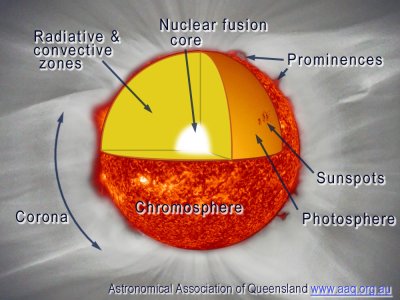
There is a thin layer of very hot gas just above the photosphere called the chromosphere (from the Greek word for colour, chromos). Glowing loops of hydrogen plasma called prominences can often occur suspended in the Sun’s magnetic field above the chromosphere. Prominences are usually associated with sunspots.
The Sun is surrounded by a tenuous layer of extremely hot gas (at about 2 000 000°C) called the corona (from the Latin word for crown). It always surrounds the Sun but is a million times fainter than the photosphere and is normally fainter than Earth’s blue sky. However, during a total solar eclipse when the bright photosphere is hidden and the blue sky is not illuminated, the corona can easily be seen surrounding the Sun and it is one of the most dramatic sights of an eclipse. The chromosphere can usually be seen as a dramatic line of bright red around the Sun’s edge at the start and end of totality and prominences can often be seen rising above.
The corona is irregular in shape with streamers extending millions of kilometres into space. The appearance of the corona is continuously varying and is different at each eclipse. The Sun acts like a giant bar magnet, so thin rays of the corona called polar tufts usually appear at the Sun’s north and south poles. Coronal streamers, which appear distributed around the Sun, generally appear longer and closer to the Sun’s equator at sunspot minimum (low solar activity), while at sunspot maximum (high solar activity) the shape of the corona is usually more uniform with streamers more distributed around the Sun. See Figure 8 which shows the corona during a total solar eclipse. There are generally more prominences at sunspot maximum. Sunspot numbers are expected to be approaching a maximum around 2025.
Sunspots
Sunspots are relatively cool regions of the solar surface where the Sun’s magnetic field is especially strong. The number of sunspots on the Sun is a good indicator of the level of the Sun’s activity. Sunspots appear on the photosphere. Each sunspot has a dark centre called its umbra and a less dark region called its penumbra. Sunspots normally form in groups and each spot can last for weeks. Since the Sun rotates about once every 25 days, sunspots can be observed to form and rotate across the photosphere. Figure 19 shows the sunspots on the Sun’s surface that occurred in October 2003.
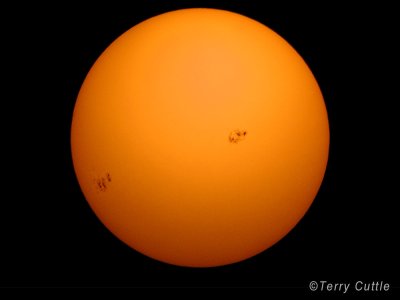
Sunspots are regions of the Sun where the magnetic field is especially strong, perhaps 3 000 times stronger than the average field of the Sun, of Earth or of a toy magnet, which are all comparable in strength. Sunspots tend to occur in groups.
The number of sunspots on the Sun waxes and wanes over an 11-year period. Figure 20 shows average monthly sunspot numbers over the last few solar cycles. The sunspot number is not actually a direct count; but is a compound value that makes allowance not only for individual spots but also for the presence of sunspot groups.
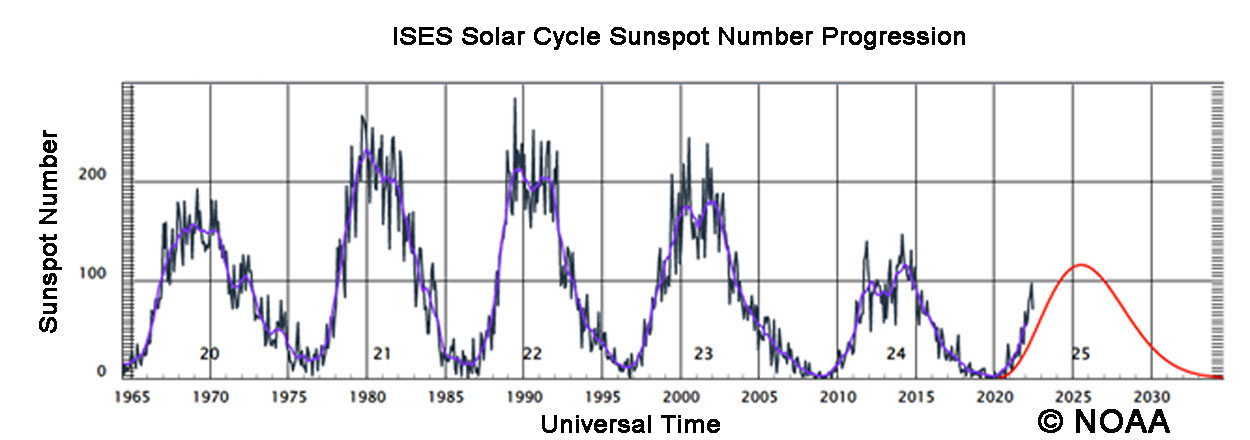
During sunspot maximum, there are more huge eruptions on the Sun called solar flares. Flares send out particles, X rays and gamma rays that can hit Earth; these can cause surges in power lines, affect passengers in high-flying aircraft or astronauts on space vehicles and contribute to creating the aurora.
Light and colours in the atmosphere
The Sun produces electromagnetic radiation over the frequency spectrum including X rays, ultraviolet light (UV), visible light, and infrared radiation (IR). Normally we see visible light as white light, but it can easily be split into the component colours of the spectrum. Objects appear to us to be their characteristic colour depending on how the light is reflected from their surface. Light can be split into a spectrum by a prism or other devices that refract light.
In the daytime, the sky appears blue because sunlight is scattered by molecules of the atmosphere. This is called Rayleigh scattering. Air molecules scatter about ten times as much blue light as red light, so if you look into the sky, it normally looks blue.
When the Sun is close to the horizon and the light that we see has travelled a very long way through Earth’s atmosphere, it has lost most of its blue and green due to scattering and so appears to be red and orange. These colours light up the sky to give us the sunset and sunrise colours. The light can be further scattered by clouds and other molecules in the atmosphere or even by volcanic emissions, providing us with some truly beautiful sunsets.
During the day, light around the horizon usually looks white, because the blue light scattered from the atmosphere between you and the horizon combines with the light from the distance (which has continued through much more atmosphere and is red) to appear white. This can also explain why during a total solar eclipse, the light for 360 degrees around the horizon appears as sunset colours. The area around you at the time of the eclipse is in shadow so there is no blue light scattered from the atmosphere. The light from outside the shadow is the red and orange light, without any blue light from the sky close to you to compensate for it.
During a total lunar eclipse, the only light to reach the Moon from the Sun is the red sunset light refracted through Earth’s atmosphere, so making the totally eclipsed Moon appear as a dark red colour.
Sun facts and statistics
- The Sun’s diameter is 1 392 000 km (= 109 times the diameter of Earth or 1 300 000 times the volume of Earth).
- Perihelion (minimum distance of Earth from the Sun) is 147 098 000 km; Aphelion (maximum distance of Earth from the Sun) is 152 098 000 km. The average distance from Earth to the Sun is 149 597 870 km. This is known as the Astronomical Unit.
- The Sun’s mass is 1.99 x 1030 kg (333 000 Earths and about 99.8% of the mass of the solar system.
- Rotation period at the equator is 25.05 days.
- Composition by mass is approximately 75% hydrogen, 24% Helium, 1% other.
- The time taken for light to travel from the Sun to Earth is about 8.3 minutes, so we see the Sun as it was 8.3 minutes ago.
The Moon
The Moon is often the most prominent object in the night-time sky and is of course the reason why we can have solar and lunar eclipses.
The appearance of the Moon
The Moon is a rocky body but unlike Earth, it has no atmosphere and no known life or liquid water. As it orbits Earth, the Moon keeps essentially the same face toward Earth, because a slight bulge of matter exists in the side of the Moon that faces Earth, allowing Earth's gravity to capture the Moon's rotation. As a result, the Moon turns once on its axis during each of its orbits around Earth.
The Moon is a little more than one-quarter the diameter of Earth. This makes it the largest substantial satellite (moon) of the planets in the solar system when compared to its parent planet. Three moons of Jupiter and one of Saturn are physically larger than our moon.
Even with the naked eye, we can see that the surface of the Moon is varied in structure. The fact that the Moon has large flat areas and craters was discovered by Galileo when he firstly turned his small telescope to look at the Moon in 1609. The large flat areas are called maria (pronounced "MAR ee uh"; singular, mare, pronounced "MA ray"). Maria means "seas," though there is no water in these lunar seas.
The view of the Moon through even a small telescope can be breathtaking. See figure 21. You can see that the maria are very flat and that there are other regions, the highlands that are covered with craters. There are relatively few craters on the maria. These "seas" have, instead, been made flat by volcanic material – lava that flowed from beneath the lunar surface more than 3 billion years ago. This lava covered whatever craters existed at that time, so the craters now visible in the maria were formed by the impact of interplanetary rocks (meteorites) that have hit the Moon since then.
When observing the Moon with binoculars or with a telescope, you will find it most interesting to observe the terminator, the line separating light from dark (day from night, on the Moon). At the terminator, we are seeing the region where the Sun's rays are shining on the Moon at the most oblique angle and therefore shadows are longest there. This increases the contrast of the surface features. The height of lunar mountains can be calculated by measuring the lengths of their shadows.
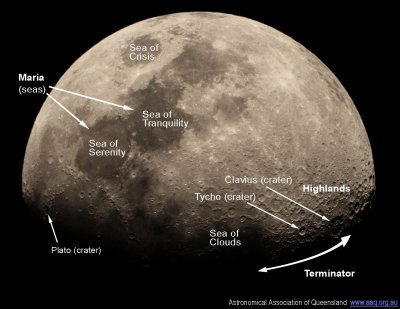
The Moon’s orbit
The Moon orbits Earth about every 27.3 days with respect to the stars. This is called a sidereal month. However, during that time, Earth and the Moon have moved as a system about 1/12 of the way in their yearly orbit around the Sun. So, if the Moon at a certain point in its orbit is directly between Earth and the Sun, 27.3 days later it has not quite returned to that point directly between Earth and the Sun. The Moon must orbit Earth a bit further to get back to the same place with respect to the line between Earth and the Sun. The Moon reaches this point in a couple of days, making the synodic month (also called a lunar month) of the Moon equal to about 29.5 days. The synodic period is the interval between two successive conjunctions of two celestial bodies; in this case conjunctions of the Moon and Sun as observed from Earth. It is the time between two successive new moons (or full moons) and it is the synodic months that are taken into account in lunar calendars. See Figure 22.

The Moon’s phases
As the Moon orbits Earth, it goes through its various phases, from new moon to first quarter, to full moon to last quarter and back to new moon. Refer to figure 23. Like Earth, one half of the Moon is always illuminated by the Sun and the phase of the Moon that we see at any time is as a result of the fraction of the illuminated half that we can see.
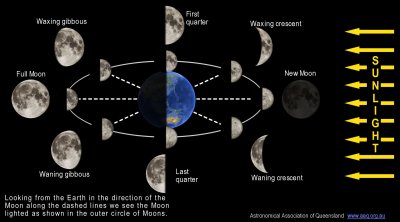
In figure 22, looking from the Earth in the direction of the Moon along the dashed lines we see the Moon lighted as shown in the outer circle of Moons. In between the new moon and the full moon, the Moon appears as a crescent (less than half-illuminated), a half-moon (half the face we see illuminated) or is gibbous (more than half-illuminated). Gibbous comes from the Latin word that means a hump, or bulging. The first half moon after the new moon is called the first quarter, since we are one-quarter of the way through the monthly cycle of phases. The half moon after the moon is full is called the last quarter (also known as third quarter). While the phases are changing from new to full, with more of the illuminated side of the Moon becoming visible, we say the Moon is waxing. Between full and new phases, the Moon is waning.
The angle between Earth, the Moon and the Sun determines which phase will appear, so the time of night the Moon rises depends on its phase. A full moon rises when the Sun sets and so will stay in the sky most of the night. A new moon rises when the Sun rises and sets when the Sun sets. The Moon rises about 50 minutes later each night. A first-quarter moon thus rises at about midday and sets around midnight and so is at its highest point for the day at sunset. Around third quarter, it rises late at night. You can often see the Moon in the daytime, especially if you firstly figure out approximately where to look for it. Since the Moon's orbit is elliptical, the Moon's speed around Earth varies, making the period between its phases vary slightly.
Solar eclipses, when the Moon casts a shadow on Earth, can only happen at new moon. Lunar eclipses, when Earth casts a shadow on the Moon, can only happen at full moon.
A NASA visualisation of the Moon moving through its phases in 2023 in various forms is at: https://svs.gsfc.nasa.gov/5048
Moon facts and statistics
- Diameter is 3 476 km (about a quarter the diameter of Earth).
- Perigee (minimum distance from Earth) is on average about 356 400 km; Apogee (maximum distance from Earth) is on average about 406 700 km. The average distance from Earth is about 384 400 km.
- Mass is 7.348 x 1022 kg (about one eightieth of the mass of Earth).
- Inclination of the Moon’s orbit to the Ecliptic (plane of Earth’s orbit) is 5.145º.
